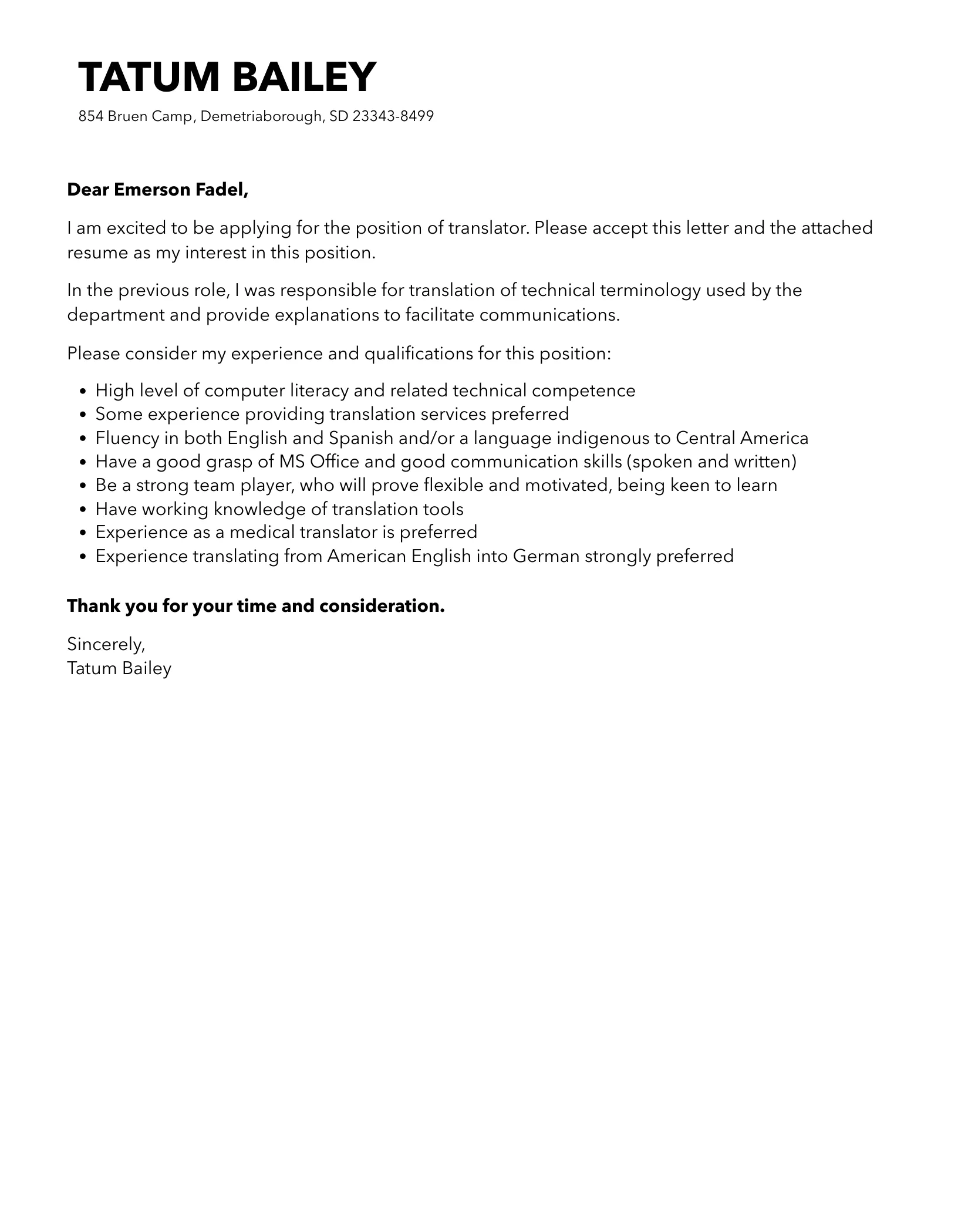Understanding the Purpose of a Translator Cover Letter
A translator cover letter is more than just a formality it’s your first impression. It serves as a crucial introduction, providing an opportunity to showcase your skills, experience, and passion for translation. Unlike a resume, which offers a factual overview, your cover letter allows you to tell a compelling story, demonstrating why you’re the perfect fit for the specific translation role. It gives you the chance to highlight your unique qualifications and personality, setting you apart from other applicants. The purpose is not just to list your credentials but to persuade the hiring manager that you possess the linguistic abilities, cultural understanding, and professional demeanor necessary to excel as a translator. Moreover, it demonstrates your communication skills and attention to detail, essential qualities for any translator.
Highlighting Your Language Skills
Your language skills are the cornerstone of your ability as a translator. Therefore, your cover letter must clearly and concisely articulate your proficiency in the languages you work with. Specify your native language and the languages you translate to and from. Go beyond simply stating your fluency; use descriptive terms such as ’native proficiency,’ ‘fluent,’ ‘proficient,’ or ‘advanced.’ When possible, mention any certifications or language assessments you have completed, such as the TOEFL, IELTS, or DELE. Highlighting the specific language pairs you specialize in (e.g., English to Spanish, French to German) helps the hiring manager quickly assess your suitability for the role. Furthermore, briefly mention any specialized terminology you are familiar with, such as legal medical, or technical vocabulary, as this can be a significant advantage.
Showcasing Your Translation Experience
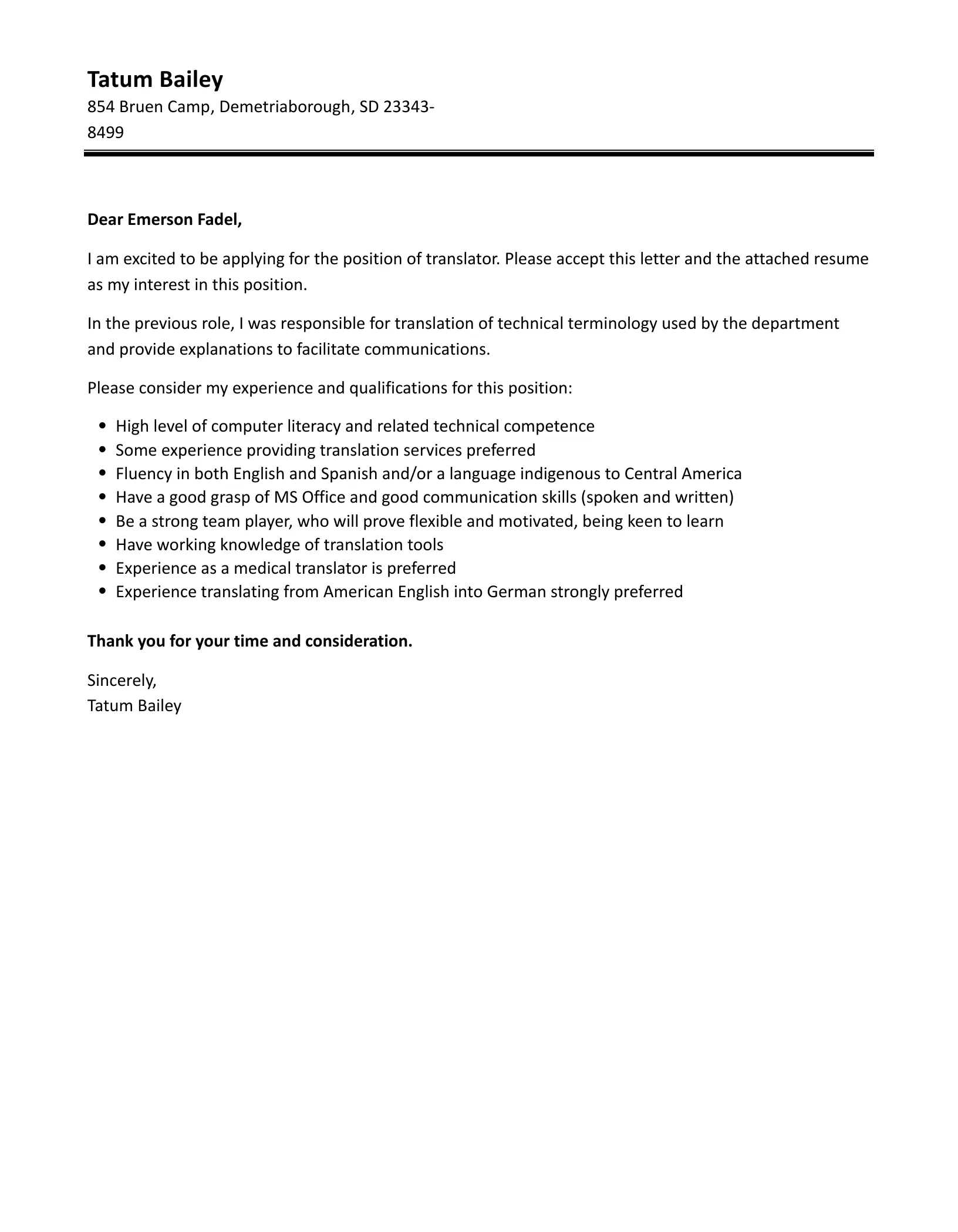
Detailing your translation experience is vital. Instead of just listing previous roles, provide specific examples of the types of projects you have worked on. Describe the subject matter of the documents you’ve translated (e.g., marketing materials, technical manuals, legal contracts) and the industries you have experience in (e.g., healthcare, finance, technology). If possible, mention the volume of translation work you have handled (e.g., number of words translated, projects completed). Emphasize any experience with translation tools (CAT tools) such as SDL Trados Studio, memoQ, or other relevant software. Mentioning your experience in different translation specializations (e.g., localization, interpreting, transcreation) can be highly beneficial, particularly if the job description specifies a particular area of expertise.
Quantifying Your Achievements
To make your cover letter impactful, quantify your achievements whenever possible. Instead of saying ‘improved translation accuracy,’ state ‘improved translation accuracy by 15% on average, as measured by client feedback.’ If you’ve completed a large project, mention the word count or the scope of the project (e.g., ‘Translated a 50,000-word technical manual’). If you have received positive feedback or testimonials from clients, consider briefly quoting them. Quantifiable achievements demonstrate your ability to deliver results and provide concrete evidence of your skills. Including metrics makes your accomplishments more credible and showcases your value as a translator. It helps the hiring manager easily understand the impact you can make on their team or projects.
Formatting Your Translator Cover Letter
Contact Information and Salutation
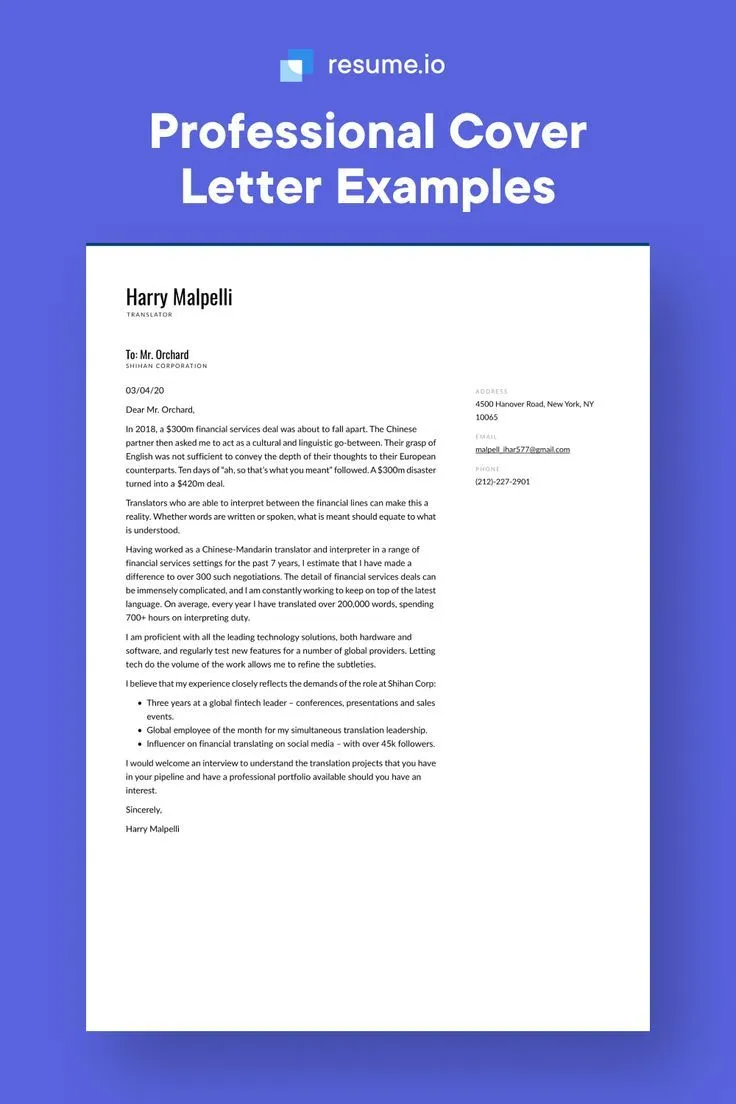
Your cover letter should start with your contact information at the top including your name, phone number, email address, and optionally, your LinkedIn profile URL. Use a professional and clear format for your contact details. Following your contact information, address the hiring manager directly. If possible, find out the name of the person in charge of hiring this is the most personal and engaging option. If you’re unsure, use a general greeting such as ‘Dear Hiring Manager’. Avoid generic salutations like ‘To Whom It May Concern’ as they can make your application seem impersonal and less thoughtful. This shows your attention to detail and respect for the reader.
Body Paragraphs Crafting Compelling Content
The body of your cover letter is where you truly sell yourself. Begin with a strong opening paragraph that immediately grabs the reader’s attention and clearly states your interest in the position. In the subsequent paragraphs, highlight your key skills and experience, focusing on the qualifications that match the job description. Use clear, concise language, and avoid jargon or overly complex sentences. Provide specific examples to support your claims, and ensure your writing style is professional and polished. Structure your paragraphs logically, with each one addressing a specific point or aspect of your qualifications. This includes showcasing your understanding of cultural nuances and the importance of accuracy in translation. Your cover letter needs to be an effective demonstration of your writing and translation skills.
Closing and Call to Action
Your closing paragraph should reiterate your interest in the position and thank the hiring manager for their time and consideration. Include a call to action, such as stating your availability for an interview or your willingness to provide samples of your work. Make sure your closing is polite and professional. Use a formal closing such as ‘Sincerely’ or ‘Yours faithfully’ followed by your full name. The call to action shows your proactive attitude and desire for the role, encouraging the hiring manager to move forward in the recruitment process. It’s a final opportunity to leave a lasting impression.
Proofreading and Editing
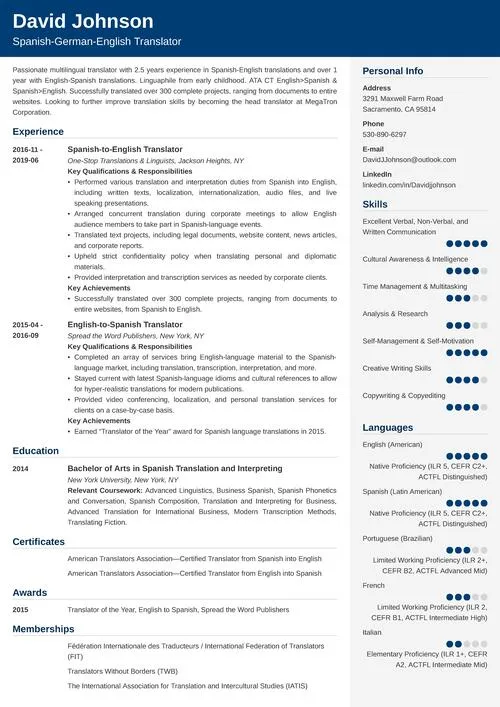
Proofreading and editing your cover letter is non-negotiable. As a translator, attention to detail is one of your primary assets and your cover letter must reflect that. Carefully review your cover letter for any grammatical errors, typos, or inconsistencies. Use a grammar checker, but also read your letter aloud to catch any awkward phrasing or mistakes that you might have missed. Ideally, have someone else proofread it as well, as a fresh pair of eyes can often spot errors that you have overlooked. A polished, error-free cover letter demonstrates your professionalism and commitment to quality and demonstrates your attention to detail.
Tailoring Your Cover Letter
Researching the Company
Before sending your cover letter, research the company you’re applying to. Understanding the company’s mission, values, and the types of projects they undertake is crucial. This knowledge allows you to tailor your cover letter, demonstrating how your skills and experience align with their specific needs. Visit the company’s website, read their social media, and, if possible, research their previous projects. Mentioning the company’s name and specific projects in your cover letter shows that you’ve taken the time to learn about them and are genuinely interested in the role. Tailoring shows your investment in the role and shows that you’re more than just a generic applicant. This demonstrates your initiative and genuine interest.
Customizing for Each Application
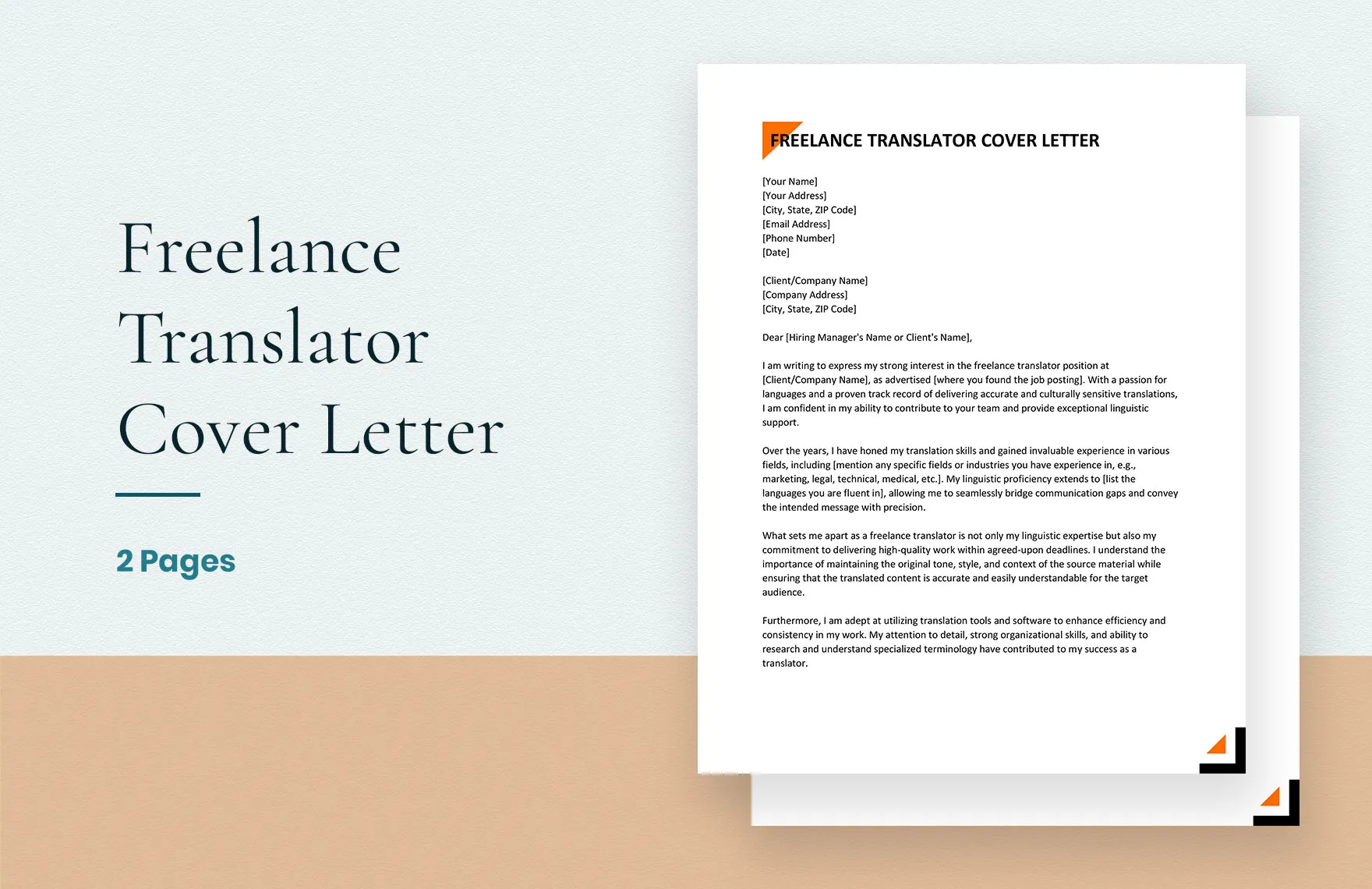
Never use a generic cover letter for every job application. Instead, customize your letter for each position you apply for. Review the job description carefully and identify the key requirements and desired skills. Highlight the relevant experiences and skills that match those requirements. Personalize your cover letter by mentioning specific projects, clients, or industry experiences that are relevant to the role. This will make your cover letter more compelling and increase your chances of getting noticed. Customization demonstrates your adaptability and shows that you understand the specific needs of the company and the position.
Showcasing Relevant Projects
When tailoring your cover letter, highlight the projects that best align with the job requirements. If the job description mentions a specific type of translation (e.g., medical, legal, technical), showcase your experience in that area. Provide brief details about the projects you have worked on, including the languages involved, the subject matter, and the clients. If you can, mention any positive outcomes or achievements from these projects. This will help the hiring manager see how your skills and experience translate directly to the role they are trying to fill. It provides concrete examples that show the quality and nature of your work.
Avoiding Common Mistakes
Generic Templates and Overused Phrases
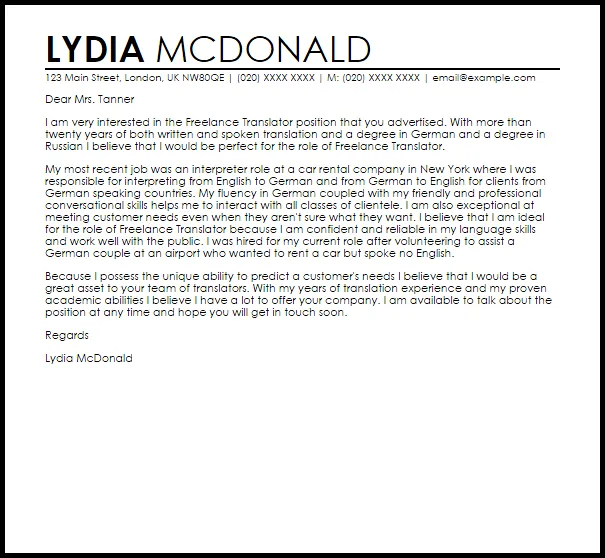
One of the biggest mistakes is using generic templates or overused phrases. These make your cover letter sound impersonal and can fail to capture the hiring manager’s attention. Avoid phrases like ‘I am writing to express my interest’ or ‘I am a highly motivated individual.’ Instead, use original and engaging language that reflects your personality and passion for translation. Tailoring your cover letter is essential to avoid sounding generic and make sure it shows your unique skills and experiences. Write in your own voice and make your application stand out.
Typos and Grammatical Errors
Typos and grammatical errors are a major red flag for a translator. They demonstrate a lack of attention to detail, which is crucial for accurate translations. Always proofread your cover letter carefully, and consider using a grammar checker. Have someone else review your letter to catch any errors you may have missed. An error-free cover letter shows that you take your work seriously and have the skills necessary to deliver high-quality translations. Remember that your cover letter is a direct reflection of your translation skills.
Lack of Enthusiasm
A cover letter that lacks enthusiasm or passion is likely to be overlooked. Hiring managers want to see your genuine interest in the position and the company. Express your excitement about the opportunity, and explain why you are a good fit. Highlight what motivates you in translation, and how your skills align with the company’s goals. Showing enthusiasm can significantly increase your chances of making a positive impression. Injecting personality and highlighting your specific interests in translation work is essential, so the hiring manager can understand your passion.
Including a Translator Cover Letter Sample
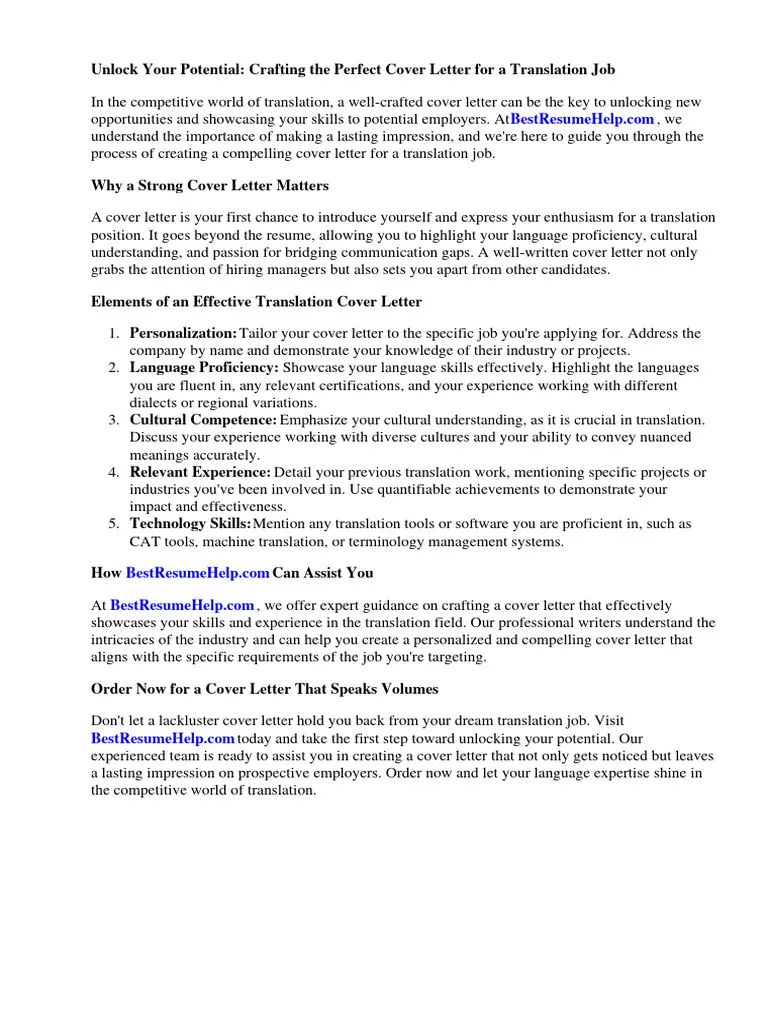
Here’s a sample to help you get started. Remember to customize it to fit your specific situation:
[Your Name] [Your Address] [Your Phone Number] [Your Email]
[Date]
[Hiring Manager Name] [Hiring Manager Title] [Company Name] [Company Address]
Dear [Hiring Manager Name],
I am writing to express my interest in the Translator position at [Company Name], as advertised on [Platform]. With a proven track record in [Language Pair] translation, I am confident I can bring significant value to your team.
In my previous role at [Previous Company], I translated over [Number] words of [Type of document], consistently meeting deadlines and maintaining a high level of accuracy. My proficiency in translation tools, such as [CAT Tool], allowed me to improve efficiency by [Percentage].
I am particularly drawn to [Company Name] because of [Reason]. My skills and experience align well with your needs and I am eager to contribute to your team’s success.
Thank you for your time and consideration. I look forward to the possibility of discussing my qualifications further.
Sincerely, [Your Name]
Remember to tailor this sample to your personal experience and the job description. Good luck with your job search!
